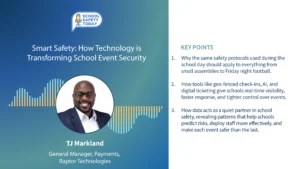How Campus CIOs can Keep Up With Rising WiFi and Connectivity Demands
If colleges and universities want to achieve their strategic goals in the digital era, they need a reliable, high-speed network infrastructure. But with the demands on campus networks growing exponentially, how can higher-education CIOs stay ahead of these requirements and plan effectively for future needs?
Students and faculty now expect seamless, ubiquitous WiFi access across the entire campus, and residential students arrive with an ever-increasing number of devices requiring connectivity. Plus, college and university CIOs have to plan for the Internet of Things, the research needs of faculty, and the capacity to handle future technologies as well.
According to the most recent “State of the Residential Network Study” from the Association of College and University Housing Officers International (ACUHO-I), the average student brings five to seven internet-connected devices to campus — and students have come to expect reliable wireless access on all of them.
“With student expectations for ‘always-on’ WiFi for any device anywhere, campus networks have become one of the most challenging initiatives for universities today,” says ACUHO-I Chief Executive Mary M. DeNiro.
More than 95 percent of campus leaders believe a high-performing network is critical for attracting and retaining students, according to the ResNet study. Three out of four colleges and universities now offer 1 Gbps or more bandwidth per student on their residential networks — a threefold increase since 2012 — and the same percentage of institutions now offer WiFi access throughout at least 80 percent of their campus.
In response to soaring demands, about one in five campus leaders say they’re updating their ResNet strategic plans each year, the association says.
Understanding needs
Campus CIOs can successfully anticipate infrastructure requirements and stay ahead of the demand by studying trends and understanding the needs of their campus community.
At Pace University in New York, CIO Paul Dampier and his staff maintain close contact with the university’s 13,000-plus students and faculty through multiple means to determine IT infrastructure needs. “Our customers’ needs change frequently,” Dampier observes. “Working closely with them enables IT to be more responsive.”
Representatives from the IT department meet every week with the major administrative functions of the university to discuss current needs and areas for future growth. At least once a semester, IT also meets with the dean of students, the senior residential leadership team, and faculty technology committees for each campus. In addition, student employees make up about a quarter of the FTE workforce within the IT department, and IT staff rely on their feedback to understand the needs of students. “Their feedback is invaluable,” Dampier says.
Campus CIOs should use both qualitative and quantitative measures to understand their IT infrastructure needs and plan accordingly. Besides tracking bandwidth usage over time, Mount Holyoke College CIO Alex Wirth-Cauchon and his staff conduct regular surveys of stakeholders and analyze help desk ticket patterns to determine needs.
“We need to be user-centered and iterative in our planning and execution,” he says. “As technology is adopted, faculty, staff, and especially students bring their own creativity and expertise to shape the way it is used. It’s important to establish many channels to hear and learn from this creativity and expertise.”
Rob Lowden, CIO of Indiana University, says his institution generally sees its network traffic grow by about 20 percent year over year. “We try not to exceed 50 percent utilization of capacity on our network at any point,” he says, “and when we do, we start planning for upgrades.”
This year, because there are fewer people on campus as a result of the pandemic, IU has had less traffic on its network. “We were typically seeing peak traffic at around 25 Gbps pre-pandemic and are now seeing it around 20 Gbps, so we are seeing traffic down roughly 20 percent,” he says. However, “traffic to our virtual private network for off-campus users who are trying to access certain on-campus resources is up exponentially from pre-pandemic levels. As a result, we had to increase our VPN capacity.”
Pace University had also been experiencing 20-percent increases in network traffic each year before the pandemic. “Our bandwidth needs increase [dramatically] each academic year as new students bring in their latest technical devices,” Dampier says. “I used to think two or three devices [for each student] was extreme, but now that number is into double digits.”
Key advice
To keep ahead of infrastructure needs, campus CIOs must not only anticipate what these are but also budget effectively for network improvements. Here are three ways to do this successfully.
Make ongoing improvements.
CIOs can keep up with rapidly evolving needs more effectively by making small, incremental changes each year instead of major network upgrades every five to 10 years.
“A big lift every few years was the old model. Today, network technology needs to be continuously upgraded — and CIOs need a budget and networking team that builds out capacity incrementally,” Dampier says.
IU has a Network Master Plan that is constantly refreshing the university’s core network hardware, wireless and wired access points, and connecting cables “so that no area on campus is appreciably behind current standards,” Lowden says. The university has also adopted a lifecycle approach to budgeting for network infrastructure.
“If we estimate the lifespan of a critical piece of equipment is five years, we set aside one-fifth of its cost each year so that we have the funds available to replace it at the end of its effective lifespan,” he explains. “This way, we are not surprised by any major refreshes or large-scale capital needs.”
Move to cloud-based services.
“CIOs can offset network costs on campus by using cloud and hosted cloud services as much as possible,” Dampier says. This not only cuts down on network traffic but also positions institutions well for maintaining continuity of service during a crisis, such as the need for remote learning and working that colleges and universities are currently experiencing during the pandemic.
Focus on strategic goals.
Campus CIOs might need to make some hard decisions about where to focus limited network resources. In that case, as with all decisions, CIOs should be guided by their institution’s strategic goals.
“The most important questions we need to ask are about the mission and the strategic direction of the campus,” Wirth-Cauchon says. “The answers to these questions will allow CIOs to focus on solutions that are grounded in — and give life to — the institution’s aspirations.”
Recognizing that bandwidth needs were increasingly “relentlessly,” leaders within Mount Holyoke College’s Library, Information, and Technology Services division collaborated with their colleagues in Financial Services to develop a model for funding IT infrastructure “through ongoing reserve funding based on multi-year projections,” Wirth-Cauchon says. “This has allowed us to make purchasing and installation decisions with a long-range horizon in mind.”
The mission and strategy of the college has helped guide the investment of those funds. For instance, “we added wireless access to selected remote outdoor areas of the campus that are used as an environmental studies lab, while not adding wireless access to many other outdoor areas,” he explains. “This allows for spaces to ‘unplug’ and reflect.”
Wirth-Cauchon advises fellow CIOs to “strategize, plan, and make technology decisions from the outside in.” That is, “start with the mission and strategic direction of the institution — and [proceed] with a robust and evolving understanding of those you are serving.”
—
Follow MarketScale on social media for more EdTech updates!
Twitter – @MarketScale
Facebook – facebook.com/marketscale
LinkedIn – linkedin.com/company/marketscale









